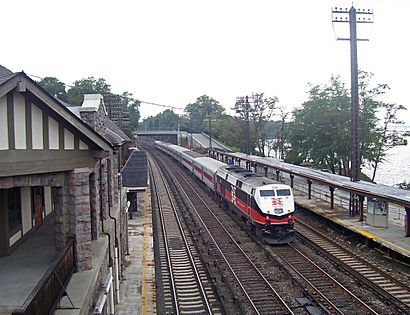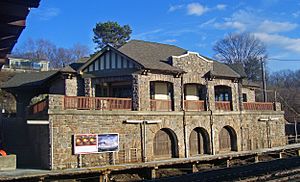Philipse Manor station facts for kids
Quick facts for kids
Philipse Manor
|
|||||||||||
|---|---|---|---|---|---|---|---|---|---|---|---|

A north-bound express train passes through the station
|
|||||||||||
| Location | 78 Riverside Drive, Sleepy Hollow, New York | ||||||||||
| Coordinates | 41°5′41″N 73°52′10″W / 41.09472°N 73.86944°W | ||||||||||
| Line(s) | Empire Corridor | ||||||||||
| Platforms | 2 side platforms | ||||||||||
| Tracks | 4 | ||||||||||
| Construction | |||||||||||
| Parking | PMIA permit West Side Village of SH on East Side |
||||||||||
| Other information | |||||||||||
| Fare zone | 5 | ||||||||||
| History | |||||||||||
| Opened | January 30, 1911 | ||||||||||
| Electrified | 700V (DC) third rail | ||||||||||
| Services | |||||||||||
|
|||||||||||
| Former services | |||||||||||
|
|||||||||||
|
Philipse Manor Railroad Station
|
|||||||||||
| Area | less than one acre | ||||||||||
| Architectural style | Tudor revival | ||||||||||
| NRHP reference No. | 91000237 | ||||||||||
| Added to NRHP | March 14, 1991 | ||||||||||
The Philipse Manor station is a train stop in the Philipse Manor area of Sleepy Hollow, New York. It's part of the Metro-North Railroad's Hudson Line. This line helps people travel to and from work.
Trains go to New York City often, especially during busy times. It's about 25.7 miles (41.4 km) from Grand Central Terminal in New York City. A train ride usually takes about 57 minutes. Electric trains called "electric multiple units" (EMUs) use this station.
The station was built around 1910 and opened on January 30, 1911. Its unique Tudorbethan style of architecture is very special. Because of its design, it's listed on the National Register of Historic Places. This means it's an important historical building. It's one of only two stations on the Hudson Line to get this recognition.
Contents
History of Philipse Manor Station
The New York Central Railroad helped towns along the Hudson River grow. In the late 1800s, it became easier for people to live in big houses by the river. Towns like Irvington, Tarrytown, and North Tarrytown (now Sleepy Hollow) started to get bigger.
Developers saw a chance to build new homes. In 1900, a developer named John Brisben Walker bought land in North Tarrytown. He divided it into smaller plots for houses. He promised train access, but it didn't happen right away.
Walker then sold the land to William Bell. Bell finished the project and named the area Philipse Manor. He built the train station and gave it to the railroad company. Train service at Philipse Manor began on January 30, 1911.
The station was used by the railroad for many years. Later, the Metropolitan Transportation Authority (MTA) took over the train services. They eventually closed the station building. This was because people started buying tickets using machines.
The old station building was later given a new purpose. It became the Hudson Valley Writers' Center. This group helped fix up the building. They even won an award for their work in 2005.
Around 2008, the MTA started making the platforms longer. This helps more trains fit at the station. It also means more people can use the trains. This project was part of a bigger plan for all the Rivertowns stations.
Station Design and Tracks
The Original Station Building
The main station building is no longer used for trains. It's a one-story building with eight sides and a sloped roof. It's made of rough granite stone. The building was built into a hill next to the tracks. This meant people could go through the basement to reach the trains. Those doors are now closed.
The front of the building has two covered entrances. These are supported by strong granite pillars. The roof was originally made of slate tiles. Now, it has asphalt shingles.
Inside, the old fireplace is made of different colored granite. There are also old iron radiators. Dark oak wood covers the walls, making them look like fancy paneling. There are also decorative designs near the ceiling.
Platforms and Train Tracks
The station has two long platforms, one on each side of the tracks. Each platform is long enough for eight train cars.
The newer part of the station has two long concrete platforms. They have dark-green metal shelters to protect people from the weather. In between the platforms are four train tracks. All tracks have a "third rail" which provides electricity to the trains.
The two middle tracks are for express trains. These trains do not stop at Philipse Manor. Diesel-powered Amtrak and Metro-North trains also use these tracks. These trains go to places like Poughkeepsie where there are no electric rails. A green overpass bridge connects the two platforms.
| M | Mezzanine | Connection between platforms |
| P Platform level |
Street level | Eastern exit/entrance and parking |
| Side platform |
||
| Track 3 | ← Hudson Line toward Croton–Harmon (Scarborough) | |
| Track 1 | ← Hudson Line express service do not stop here ← Empire Corridor services do not stop here |
|
| Track 2 | Empire Corridor services do not stop here → Hudson Line express service do not stop here → |
|
| Track 4 | Hudson Line toward Grand Central (Tarrytown) → | |
| Side platform |
||
| Street level | Western exit/entrance and parking | |


